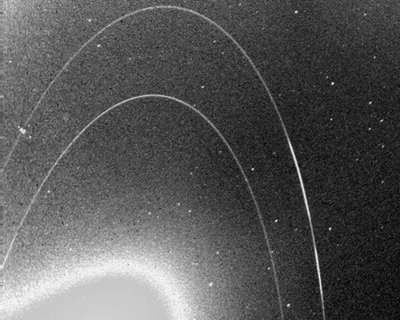 Unlike the rings of its neighbor Saturn, Neptune’s rings are faint and less dense. Even the densest of the five rings of Neptune pale in comparison to the less dense rings of Saturn. It is comparable to Jupiter’s rings that are mostly made of dust particles. These five Neptune rings were discovered by the Voyager 2 in 1989 and has been studied by astronomers ever since.
Unlike the rings of its neighbor Saturn, Neptune’s rings are faint and less dense. Even the densest of the five rings of Neptune pale in comparison to the less dense rings of Saturn. It is comparable to Jupiter’s rings that are mostly made of dust particles. These five Neptune rings were discovered by the Voyager 2 in 1989 and has been studied by astronomers ever since.
The Neptune rings are named after the five scientists that contributed most in the study of the planet:
- Galle ring – Named after the German astronomer Johann Gottfried Galle. It is the ring closest to Neptune about 41,000 km away from the surface and is estimated to be 2,000 kilometers wide. It is composed mainly of dust particles amounting to at least 40% of the ring’s material.
- Le Verrier ring – Named after the French mathematician Ubain Le Verrier who predicted the existence of Neptune through mathematics without using any direct observation of the planet itself. It is a narrow ring with a width of only 113 kilometers and orbits 53,200 kilometers away from Neptune. Like the Galle ring, it is composed mainly of dust.
- Lassell ring – Named after the English astronomer William Lassell who discovered the first and largest moon of Neptune, Triton, 17 days after the planet’s discovery. It is the widest of the five rings with a width two times that of the Galle ring. Its dust composition is around 20% – 40%.
- Arago ring – Named after the French astronomer, mathematician and physicist Francois Arago. It is narrower than the Le Verrier ring with a width of only 100 kilometers.
- Adams ring – Named by the British astronomer and mathematician John Couch Adams who, like Le Verrier, predicted Neptune’s existence and its location using mathematics. The Adams ring is the outermost ring and is the most closely studied ring. It is also the narrowest of Neptune’s ring being only about 35 kilometers wide. Adams ring acts like a shepherd, Neptune’s Galatea that creates the wiggles in the ring.
Rings of Neptune
